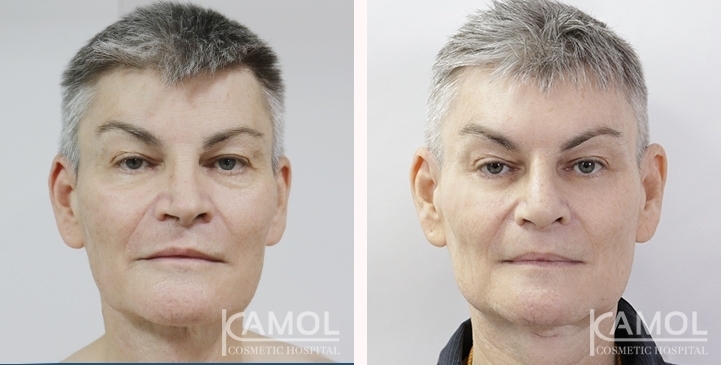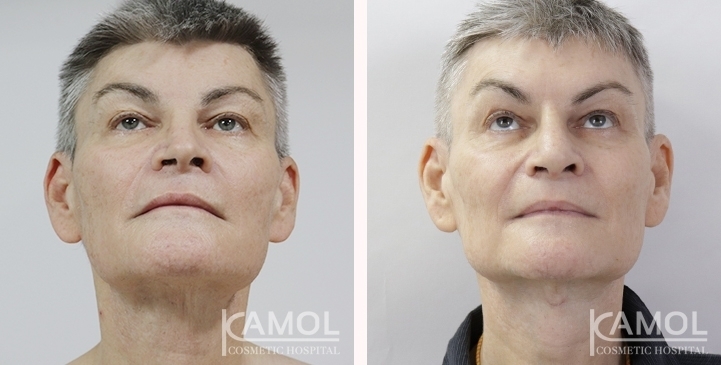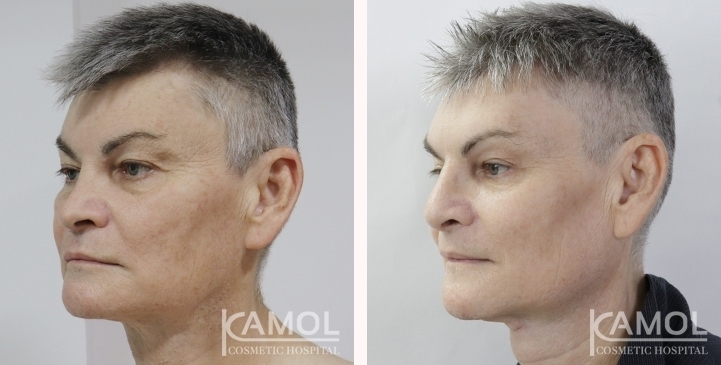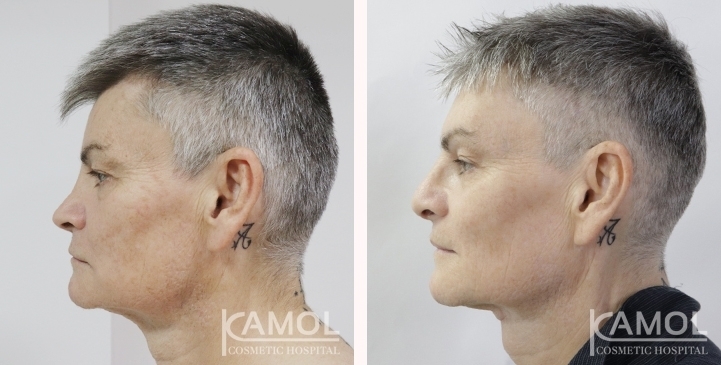What defines a Masculine Face?
A masculine face is typically characterized by a strong jawline, a prominent brow ridge, and a larger nose. These facial features are thought to be associated with higher levels of testosterone in men, which can result in increased muscle mass, body hair, and a deeper voice. Additionally, masculine faces may have a more angular shape and a greater distance between the eyes, nose, and mouth.
How to achieve a more Masculine Face surgically?
There are several surgical procedures that can be used to achieve a more masculine face, including:
- Jaw surgery: This procedure can help to create a stronger jawline and a more defined chin.
- Brow lift: A brow lift can help to create a more prominent brow ridge and a more masculine forehead.
- Rhinoplasty: A nose job can help to create a larger, more masculine nose.
- Genioplasty: A procedure that repositions the chin to create a stronger jawline.
- Facial implant: Facial implant such as chin and cheek implant can be used to enhance the masculinity of the face.
It's important to note that these procedures may not give the desired results and also have risks and side effects, so it's important to consult with a qualified plastic surgeon who can help you understand the benefits, risks, and recovery time associated with these procedures.
The reasons behind the desire for facial harmonization with Facial Contouring:
Facial contouring, also known as facial reshaping or facial sculpting, is a cosmetic procedure that alters the shape of the face to create a more balanced and symmetrical appearance. People may desire facial contouring for a variety of reasons, including:
- Correct asymmetry or imbalance in the facial features
- Improve the proportions of the face
- Enhance facial features such as the jawline, cheekbones, or chin
- Create a more youthful appearance
- Boost self-confidence and self-esteem
It is important to note that the procedure may come with certain risks and side effects. Additionally, it is also important that the individual has realistic expectations about the outcome of the procedure
The Advantages of Facial Contouring Surgery:
Facial contouring surgery offers several advantages for individuals who desire a more balanced and symmetrical appearance. Some of the advantages of facial contouring surgery include:
- Improved facial proportions: Facial contouring surgery can help to create a more harmonious and balanced appearance by adjusting the proportions of the face.
- Enhanced facial features: Facial contouring surgery can be used to enhance the appearance of specific facial features, such as the jawline, cheekbones, or chin.
- Prominent appearance: Facial contouring surgery can help to create a more prominent appearance by addressing feminine features and masculinizing them.
- Boosted self-confidence and self-esteem: Many people report feeling more confident and self-assured after undergoing facial contouring surgery.
- Long-lasting results: The results of facial contouring surgery are typically long-lasting and can be maintained with good skincare and sun protection.
Who is a good candidate for Facial Contouring Surgery?
A good candidate for facial contouring surgery would have the following characteristics:
- Good overall health: Facial contouring surgery is a surgical procedure that requires a certain level of physical and emotional health, so a good candidate would be someone who is in good general health.
- Realistic expectations: A good candidate for facial contouring surgery would have realistic expectations about the outcome of the procedure and understand that it may not be able to change everything they don't like about their face.
- Motivated: A good candidate for facial contouring surgery would be someone who is motivated to achieve the desired results and is willing to follow the after-care instructions and recommendations.
- Good skin elasticity: Facial contouring surgery can change the shape of the face, but it will not change the quality of the skin, so a good candidate would have good skin elasticity to ensure a smooth recovery and good final results.
- Non-smoker: Smoking can impede healing process and increase the risk of complications, so a good candidate would be a non-smoker.
it is important that the individual has realistic expectations about the outcome of the procedure and that a consultation with the professional is done in order to evaluate the candidate's suitability for the procedure.
Understanding the Reasons for undergoing Facial Contouring Surgery to Achieve a Masculine Appearance:
Facial contouring surgery to achieve a masculine appearance is often sought by individuals who identify as transgender men or non-binary individuals who want to align their physical appearance with their gender identity.
The goal of these procedures is to create a more masculine-looking face by altering the shape and proportions of the jaw, chin, nose, and forehead.
For some individuals, achieving a more masculine face can also be a way to feel more confident and comfortable in their own skin. It can help them to better express themselves and feel more like themselves. Additionally, some cisgender men may also seek out these procedures to correct perceived facial asymmetries or to enhance their natural features.
It's important to note that seeking facial contouring surgery is a personal decision and it's important that individuals considering these procedures consult with a qualified plastic surgeon, as well as a therapist who specializes in gender identity issues to ensure that they are making an informed decision and that the surgery aligns with their overall well-being and happiness.
What are the surgical techniques used to masculinize the face through Facial Contouring Surgery?
There are several surgical techniques that can be used to masculinize the face through facial contouring surgery. Some of the most common techniques include:
- Jaw surgery: This procedure can involve reshaping the jawline to create a more defined and masculine jaw. This can be done by shaving down the jawbone, or by using a technique called mandibular angle reduction, which involves removing a portion of the jawbone.
- Brow lift: A forehead lift or brow lift can be used to create a more prominent brow ridge and a more masculine forehead. This procedure can be done through an open or endoscopic technique, and may involve the use of a forehead implant to add volume to the area.
- Rhinoplasty: A nose job can be used to create a larger and more masculine-looking nose. This procedure can involve reshaping the nasal bones, cartilage, and skin to create a more prominent nasal bridge and tip.
- Genioplasty: A procedure that repositions the chin to create a stronger jawline. This can be done by shaving down the chin bone or by using a chin implant to add volume to the area.
- Facial implant: Facial implant such as chin and cheek implant can be used to enhance the masculinity of the face.
What are the preparations for Facial Contouring Surgery?
Preparing for facial contouring surgery typically involves the following steps:
- Consultation with a surgeon: A consultation with a qualified and experienced surgeon is typically the first step in preparing for facial contouring surgery. During the consultation, the surgeon will examine the patient's face, assess their aesthetic goals, and provide information about the procedure, including potential risks and benefits.
- Medical evaluation: The patient will be required to undergo a medical evaluation to ensure that they are in good health and that there are no underlying medical conditions that could increase the risk of complications.
- Stop smoking or using certain medications: It is important for the patient to stop smoking or using certain medications before the surgery, as these can impede the healing process and increase the risk of complications.
- Plan for recovery: The patient should plan for a period of recovery following the surgery. This may include arranging for time off work or other commitments, and arranging for help with daily activities and transportation.
- Follow pre-operative instructions: The patient will be given pre-operative instructions that should be followed closely in order to ensure the best possible outcome. This may include instructions on how to prepare for the surgery, what to expect during the recovery period, and any other information that is relevant to the procedure.
It's important to note that the preparation process will vary depending on the type of facial contouring surgery you will be undergoing and the surgeon's instructions, so it's crucial to follow the surgeon's advice.
Post-operative Care for Facial Contouring Procedure:
Facial contouring surgery Post-operative care is crucial to ensure a smooth recovery and optimal results:
- Pain management: The patient may experience some pain, swelling and bruising following the surgery, and the surgeon will provide pain management medication to help alleviate these symptoms.
- Swelling and Bruising: There may be swelling and bruising around the surgical area, and it is important to keep the head elevated to help reduce swelling and bruising.
- Wound care: The patient should follow the surgeon's instructions for caring for the surgical incisions, which may include keeping the incisions clean, dry, and covered with bandages.
- Follow-up appointments: The patient will need to follow-up with the surgeon at regular intervals after the surgery to monitor the healing process, and to ensure that the results are as expected.
- Avoiding strenuous activities: The patient should avoid strenuous activities that can increase blood pressure and may cause bleeding or other complications.
- Sun protection: The patient should avoid sun exposure to the surgical area and protect the skin with sunscreen or clothing to prevent hyperpigmentation or other complications.
- Proper nutrition: Proper nutrition will be essential to help the body heal after the surgery, and the patient should follow a healthy diet and stay hydrated.
The surgeon will let you know when you can go back to your normal activities and when you should avoid certain activities.
Risks and Complications of Facial Contouring Surgery:
As with any surgical procedure, facial contouring surgery carries certain risks and complications. Some of the potential risks and complications of facial contouring surgery include:
- Bleeding: The surgical area may bleed during or after the surgery, and the patient may require additional treatment to stop the bleeding.
- Infection: The surgical area may become infected if proper wound care is not followed, and the patient may require additional treatment to control the infection.
- Scarring: Facial contouring surgery may result in scarring, which can be more noticeable on certain areas of the face.
- Numbness or tingling: There may be temporary or permanent numbness or tingling in the surgical area due to injury of the nerves during the procedure.
- Unsatisfactory results: The patient may not be satisfied with the final results, which may require additional surgeries to correct.
- Anesthesia complications: As with any surgery performed under anesthesia, there can be risks associated with the use of anesthesia, such as allergic reactions or complications from the sedation.
- Changes in skin sensation: Some patients may experience changes in skin sensation in the surgical area, such as increased sensitivity or decreased sensation.
- Changes in hair growth: Hair growth may be affected in areas where skin is removed or repositioned.
It's important to note that these risks and complications are rare, and that most patients experience a smooth recovery and are satisfied with their results. However, it's essential to have realistic expectations, a proper consultation with a qualified and experienced surgeon, and to follow the post-operative instructions and recommendations to minimize the risk of complications.
Recovery:
Recovery from facial contouring surgery will depend on the type of procedure performed and the individual's overall health.
- Pain and swelling: The patient may experience pain and swelling around the surgical area, and the surgeon may prescribe pain medication to help alleviate these symptoms. The swelling and bruising will typically resolve within a week or two.
- Bruising: Bruising is also common after facial contouring surgery, but typically disappears within a week or two.
- Incision care: The patient should follow the surgeon's instructions for caring for the surgical incisions, which may include keeping the incisions clean, dry, and covered with bandages.
- Follow-up appointments: The patient will need to follow-up with the surgeon at regular intervals after the surgery to monitor the healing process, and to ensure that the results are as expected.
- Strenuous activities: The patient should avoid strenuous activities for several weeks after the surgery to allow the body to heal properly.
- Sun protection: The patient should avoid sun exposure to the surgical area and protect the skin with sunscreen or clothing to prevent hyperpigmentation or other complications.
- Proper nutrition: Proper nutrition will be essential to help the body heal after the surgery, and the patient should follow a healthy diet and stay hydrated.
Recovery times can vary depending on the type of facial contouring procedure you underwent. The surgeon will let you know when you can go back to your normal activities and when you should avoid certain activities.
Review Facial Masculinization







